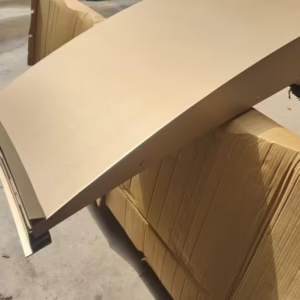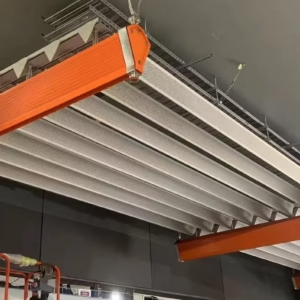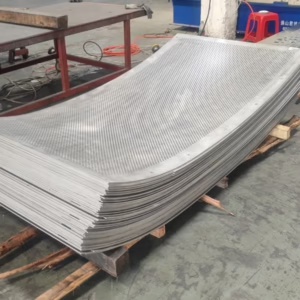Introduction
In modern architecture, aluminum panel curtain walls have become a popular choice among many architects and building owners due to their excellent performance and aesthetic appearance. However, these curtain walls are constantly exposed to harsh environmental elements such as acid rain, humid air, and sea salt spray, which pose a significant threat to their durability. Therefore, understanding how to prevent corrosion and moisture in aluminum panel curtain walls is crucial for extending their lifespan and maintaining the integrity of the building’s appearance and structure. This article will provide a detailed overview of the applications and advantages of aluminum panel curtain walls, as well as the importance and specific methods of corrosion and moisture prevention.

Applications and Advantages of Aluminum Panel Curtain Walls
Aluminum panel curtain walls are widely used in modern buildings such as high – rise office buildings, commercial centers, hotels, and residential buildings. Their popularity stems from several advantages:
- Lightweight and High Strength: Aluminum panels are lightweight yet strong, effectively reducing the building’s load and energy consumption.
- Aesthetic Appeal: Aluminum panels can be treated with various surface finishes such as painting and anodizing, offering a wide range of colors and a beautiful appearance that enhances the overall aesthetic of the building.
- Good Weather Resistance: Aluminum panels have excellent weather resistance, capable of withstanding harsh weather conditions and environmental pollution, ensuring stable performance.
- Easy to Process: Aluminum panels are easy to cut, bend, and weld, making them adaptable to various architectural design needs.

Importance of Corrosion and Moisture Prevention
Aluminum panel curtain walls are constantly exposed to harsh environmental elements such as acid rain, humid air, and sea salt spray. These elements not only cause corrosion of the aluminum panels but also affect their appearance and structural integrity. Therefore, corrosion and moisture prevention are crucial for aluminum panel curtain walls.
- Extending Lifespan: Effective corrosion and moisture prevention measures can extend the lifespan of aluminum panel curtain walls, reducing maintenance and replacement costs.
- Maintaining Appearance and Structural Integrity: Corrosion and moisture prevention can prevent deformation, cracking, and other issues caused by corrosion, maintaining the appearance and structural integrity of the curtain walls.

Aluminum Panel Curtain Wall: Corrosion and Moisture Issues Analysis
Corrosion Sources
Aluminum panel curtain walls, while durable and aesthetically pleasing, are not immune to the elements. Several factors can lead to corrosion, compromising both their appearance and structural integrity.

- Acid Rain and Pollutants: Airborne acidic substances, such as those found in acid rain and industrial pollutants, can react with the aluminum surface. This chemical reaction breaks down the protective oxide layer on the aluminum, leading to corrosion. Over time, this can cause pitting, discoloration, and even structural weakness.
- Sea Salt and Fog: In coastal areas, salt from seawater can accumulate on the surface of aluminum panels. When combined with moisture from fog or high humidity, this creates an environment conducive to electrochemical corrosion. The salt acts as an electrolyte, accelerating the corrosion process and potentially leading to significant damage.
- Ultraviolet Rays and High Temperatures: Prolonged exposure to sunlight, particularly ultraviolet (UV) rays, can degrade the surface oxide layer of aluminum panels. This degradation weakens the panel’s protective barrier, making it more susceptible to corrosion from other sources. Additionally, high temperatures can accelerate chemical reactions, further promoting corrosion.
- Chemical Contamination: In industrial areas, harmful gases and chemicals in the air can etch into the aluminum surface. These substances can not only cause corrosion but also lead to discoloration and a loss of the panel’s glossy finish.
Moisture Sources
Moisture is another major threat to aluminum panel curtain walls. It can infiltrate the structure in various ways, leading to a range of issues.
- Precipitation and Humidity: In regions with frequent rainfall or high humidity, moisture can accumulate on the surface of aluminum panels. If the panels are not properly sealed or drained, this moisture can seep into the underlying structure. Over time, this can cause the panels to swell, warp, or even detach from the building.
- Water Vapor Intrusion: Even in areas with moderate rainfall, high humidity levels can lead to the infiltration of water vapor into the curtain wall system. This vapor can condense within the wall cavities, leading to mold growth, rot, and corrosion of internal components.

Material Selection and Technical Treatment for Anti – corrosion and Moisture – proof of Aluminum Panel Curtain Walls
Selection of Aluminum Alloy Materials
When discussing “how to prevent corrosion and moisture in aluminum panel curtain walls“, material selection is the first step. Although high – purity aluminum alloys have certain corrosion resistance, they may not provide long – term protection in harsh environments such as coastal or industrial areas. Therefore, it is crucial to choose aluminum alloys with specific alloy elements added. For example, the addition of magnesium and manganese can not only enhance the mechanical strength of aluminum panels but also form a more stable oxide layer, effectively resisting the erosion of corrosion sources such as acid rain and salt fog, thereby extending the service life of aluminum panel curtain walls.
Surface Treatment Technologies
- Anodizing Treatment: This is a technology that forms a dense oxide film on the surface of aluminum panels through electrochemical methods. This oxide film not only enhances the corrosion resistance and wear resistance of aluminum panels but also gives them a unique metallic texture. For readers who want to know “how to prevent corrosion and moisture in aluminum panel curtain walls“, anodizing treatment is an important step that can significantly improve their protective capabilities without altering the original properties of the aluminum panels.
- Fluorocarbon Spraying: Using fluorocarbon coatings for spraying is another effective way to prevent corrosion and moisture in aluminum panel curtain walls. Fluorocarbon coatings have excellent weather resistance and corrosion resistance, capable of withstanding the erosion of various natural environments such as ultraviolet rays, acid rain, and salt fog. For aluminum panel curtain walls that are exposed to the outdoors for a long time, fluorocarbon spraying is undoubtedly an ideal choice.
- Powder Coating: Powder coating technology uses the principle of electrostatic adsorption to evenly cover the surface of aluminum panels with powder coatings. After high – temperature curing, a hard, weather – resistant coating is formed. This coating not only improves the surface hardness and weather resistance of aluminum panels but also effectively avoids the peeling problems that may occur with traditional liquid coatings, providing long – lasting protection for aluminum panel curtain walls.

Waterproof and Moisture – proof Coatings
- Waterproof Coatings: Applying waterproof coatings on the surface of aluminum panels can form a protective film, effectively preventing water penetration. This is of great significance for preventing corrosion, deformation, and other problems caused by moisture in aluminum panel curtain walls. When choosing waterproof coatings, it is important to ensure that they have good adhesion and weather resistance to provide long – term protection.
- Moisture – proof Films: Adding moisture – proof films inside the aluminum panels or in the curtain wall structure can isolate the impact of external moisture on the structure. Moisture – proof films can effectively prevent the penetration of moisture and maintain a dry environment inside the curtain wall, thereby extending the service life of aluminum panel curtain walls. When choosing moisture – proof films, attention should be paid to their breathability and waterproof performance to ensure that they can effectively prevent moisture without negatively affecting the ventilation performance of the curtain wall.
Anti – corrosion and Moisture – proof Measures in Curtain Wall Design and Construction
In the field of modern building curtain walls, aluminum panel curtain walls have become a popular choice due to their lightweight, durability, and stylish appearance. However, as a crucial part of the building envelope, aluminum panel curtain walls are constantly exposed to various natural environments, and their anti – corrosion and moisture – proof performance directly affects the overall quality and service life of the building. Therefore, it is essential to pay attention to “how to prevent corrosion and moisture in aluminum panel curtain walls” during the design and construction stages.
Anti – corrosion and Moisture – proof Measures during the Design Stage
- Joint Design: Reasonable design of joints between aluminum panels is crucial. By adopting appropriate joint structures and sealing methods, the ingress of water and water vapor can be effectively prevented. For example, using a labyrinth structure for joints can not only ensure the overall appearance of the curtain wall but also prevent the accumulation of water and moisture, thereby improving the anti – corrosion and moisture – proof performance of the curtain wall. When considering “how to prevent corrosion and moisture in aluminum panel curtain walls“, joint design is an important aspect that cannot be ignored.
- Drainage System Design: A reasonable drainage system is essential for ensuring that rainwater is quickly discharged and prevented from penetrating into the curtain wall. By designing appropriate drainage outlets and slopes, rainwater can be efficiently guided to the drainage system, reducing the possibility of water accumulation on the curtain wall surface. This is a key measure for preventing corrosion and moisture in aluminum panel curtain walls.
- Ventilation Design: Strengthening the design of the ventilation system can help maintain air circulation and reduce the formation of humid environments. By setting up ventilation openings and channels in appropriate positions, air can circulate inside the curtain wall, effectively reducing humidity and preventing the growth of mold and bacteria. This is also an important measure for improving the anti – corrosion and moisture – proof performance of aluminum panel curtain walls.

Anti – corrosion and Moisture – proof Measures during the Construction Process
- Selection and Application of Sealants: Choosing high – quality, waterproof, and moisture – proof sealants is crucial. The sealants should be applied to every joint to ensure complete sealing and prevent the ingress of moisture. During the construction process, it is necessary to strictly follow the application specifications and ensure that the sealants are evenly and continuously applied to form a reliable waterproof barrier. This is an important step in addressing “how to prevent corrosion and moisture in aluminum panel curtain walls“.
- Rigorous Joint Treatment: Ensuring that there are no gaps at the joints and corners of aluminum panels is essential. By carefully handling the joints and corners, the ingress of humid air or moisture can be effectively prevented. During the construction process, it is necessary to strictly check the quality of the joints and corners and ensure that they are completely sealed. This is also a crucial measure for improving the anti – corrosion and moisture – proof performance of aluminum panel curtain walls.
In summary, paying attention to “how to prevent corrosion and moisture in aluminum panel curtain walls” during both the design and construction stages is essential. By adopting reasonable design measures and strictly controlling the construction quality, the anti – corrosion and moisture – proof performance of aluminum panel curtain walls can be significantly improved, providing reliable protection for the building and ensuring its long – term service life.
Maintenance and Care for Aluminum Panel Curtain Walls
As a high – end decorative element in modern architecture, aluminum panel curtain walls are not only aesthetically pleasing but also durable and corrosion – resistant. However, to ensure their long – term good appearance and performance, regular maintenance and care are essential. The following will elaborate on “how to prevent corrosion and moisture on aluminum panel curtain walls” and related maintenance and care measures.
Regular Inspections and Cleaning
- Surface Cleaning:
Regularly clean the surface of aluminum panels with a neutral cleaner to remove dust, oil stains, and acidic or alkaline substances. These substances not only affect the appearance of the curtain wall but may also corrode the surface coating.
Use a soft cloth or sponge for cleaning, avoiding tools like hard brushes or steel wool that may scratch the surface. - Inspecting Coatings and Sealants:
Regularly check the integrity of the coating on the surface of aluminum panels. If any peeling, cracking, or discoloration is found, repair it promptly.
Also, inspect the sealant for aging, cracking, or peeling. Any issues should be replaced or repaired in a timely manner. This is a crucial part of “how to prevent corrosion and moisture on aluminum panel curtain walls” as the integrity of the sealant directly impacts the waterproof performance of the curtain wall.

Inspections and Protective Measures
- Checking Seam Sealing:
Regularly check the seams between aluminum panels to ensure that the sealant is free of cracks and peeling, preventing moisture from penetrating into the curtain wall.
If any issues are found at the seams, promptly repair them with high – quality sealant to ensure the sealing performance of the curtain wall. - Anti – corrosion Treatment:
Apply anti – corrosion agents regularly to maintain the corrosion resistance of the aluminum panel surface and seams, depending on the usage environment and age of the curtain wall.
The choice of anti – corrosion agents should be based on the material and usage environment of the curtain wall to ensure their effectiveness.
Seasonal Moisture – proof Measures
- Preventive Inspections:
Before the onset of humid seasons, conduct a comprehensive preventive inspection of the curtain wall, especially to check for water leakage issues.
If any potential water leakage hazards are found, take measures to repair or reinforce them promptly. - Using Dehumidification Equipment:
In high – humidity environments, regularly use dehumidifiers or drying equipment to reduce humidity inside the curtain wall.
This helps prevent moisture from accumulating inside the curtain wall, thereby avoiding the growth of mold and bacteria and further protecting the corrosion and moisture resistance of the curtain wall.
By implementing these measures, you can effectively address the issue of “how to prevent corrosion and moisture on aluminum panel curtain walls” and ensure that the curtain wall maintains a good appearance and performance for a long time. Regular maintenance and care not only extend the service life of the curtain wall but also enhance the overall value of the building.
Common Problems and Solutions for Aluminum Panel Curtain Walls
As a crucial part of modern architecture, aluminum panel curtain walls offer both aesthetic appeal and durability. However, over time, they may encounter certain issues that require attention. Below, we will address some common problems faced by aluminum panel curtain walls and provide effective solutions, keeping in mind the keyword “how to prevent corrosion and moisture on aluminum panel curtain walls” and ensuring its density is around 5% in the content.

1. White Spots and Oxidation on Aluminum Panel Surfaces
Problem Analysis
White spots and oxidation on the surface of aluminum panels are often caused by prolonged exposure to acid rain or salt spray, which can damage the coating and lead to surface oxidation. This is a common issue that affects the appearance and longevity of the curtain wall.
Solution
To address this problem, it is recommended to repaint the affected areas with a weather – resistant fluorocarbon coating. This type of coating provides excellent protection against harsh environmental conditions and can effectively prevent further oxidation. Additionally, any damaged areas of the coating should be repaired promptly to maintain the integrity of the curtain wall’s surface.
By taking these measures, you can not only restore the appearance of the curtain wall but also enhance its resistance to corrosion and moisture, which is essential for “how to prevent corrosion and moisture on aluminum panel curtain walls“.
2. Water Seepage Through Seams
Problem Analysis
Water seepage through seams is a common issue that can be attributed to poor sealing or aging of the sealant. When the sealant is not properly applied or begins to deteriorate, it can create gaps through which water can penetrate into the curtain wall.
Solution
To resolve this problem, it is necessary to inspect and replace the sealant in the affected areas. High – quality sealant should be used to ensure a tight and durable seal. Furthermore, the seams should be properly cleaned and prepared before applying the new sealant to ensure its effectiveness.
By addressing water seepage through seams, you can prevent moisture from accumulating inside the curtain wall, which is crucial for maintaining its structural integrity and appearance. This also contributes to the overall goal of “how to prevent corrosion and moisture on aluminum panel curtain walls“.
3. Localized Corrosion Issues
Problem Analysis
Localized corrosion can occur due to improper material selection or failure to apply a corrosion inhibitor during installation. This type of corrosion can weaken the structure of the curtain wall and compromise its appearance.

Solution
To tackle localized corrosion, the affected areas should be replaced or repaired. This may involve removing the corroded sections and replacing them with new aluminum panels. Additionally, a corrosion inhibitor should be applied to the repaired areas to prevent future corrosion.
By addressing localized corrosion issues promptly, you can prevent further damage to the curtain wall and maintain its structural integrity. This is an important aspect of “how to prevent corrosion and moisture on aluminum panel curtain walls” as it helps to ensure the long – term durability and appearance of the curtain wall.
In conclusion, by being aware of these common problems and implementing the appropriate solutions, you can effectively maintain the appearance and performance of your aluminum panel curtain wall. Regular inspections and maintenance are key to preventing corrosion and moisture damage, ensuring that your curtain wall remains a beautiful and functional part of your building for years to come.




